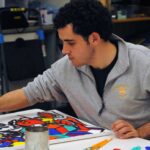In a letter she wrote home to her older brother in Quitman, Texas—the small town where Sissy grew up riding horses (and cows), fishing and baton-twirling—17-year-old Sissy Spacek gushed about meeting the famous stage actress Geraldine Page during her first visit to New York City: “I just love Gerry; she’s great, just like a plain person.”
After my phone interview with the Academy Award-winning actress, I hung up, gushing the same thing. The movie star’s so easygoing and down to earth, I felt like I was chatting with an old college friend.
Being “plain” or “ordinary” seems to be a point of pride for Spacek. Throughout her new memoir, My Extraordinary Ordinary Life, she uses it as the highest compliment for many of the people she met (and meets) in her storied life, from Loretta Lynn, the country music star she portrayed—to great acclaim—in Coal Miner's Daughter to the man who ran the filling station near her farm home in rural Virginia, where she has lived for the past 30-some years. In fact, she writes much more about others than she does of herself in the autobiography. She seems to find something fascinating in just about everyone she meets and can’t help but tell her story through all of theirs.
Falling Forward
In short, Spacek’s story is this: a bucolic childhood in rural Texas with a loving family, followed by a bold move to New York City (where her cousin, Rip Torn, and his wife, Geraldine Page, were already successful actors) to pursue her dream of becoming a singer/songwriter. She played her music in restaurants, at open mikes, and even became a one-hit wonder with the novelty song, John, You Went Too Far This Time, under the pseudonym of Rainbo. But her singing career never caught fire. By chance, she met an important agent (after being rejected by a modeling scout because of her height—or lack thereof; Sissy is a scant 5-foot-2—another agent in the same building agreed to see her out of pity) who believed in her general talent and encouraged her to try acting.
“I came from such a tiny town, and I sang and danced my entire life,” she explained, her voice sweet, almost apologetic, and melodic over the phone. “I was a big fish in a little pond there, so when I moved to New York, I was a little naïve. I just kind of fell forward. I never really imagined things wouldn’t work out. Ignorance is bliss, I guess. I just felt like once I got my foot in the door, I’d be OK.”
A small role in a small film, Prime Cut, came and went without much fanfare, but her performance caught the attention of filmmaker Terrence Malick. He cast her as Holly Sargis, a character based on the real-life story of Caril Anne Fugate, a 14-year-old who accompanied her teenage boyfriend on a cross-country killing spree in 1958, in his independent picture Badlands. The movie—and Spacek’s performance in it—were almost instantly acknowledged as cinematic classics.
Just like that, her foot was in the door.
And her heart was in acting. “Badlands was a cataclysmic experience for me,” Spacek says now. “It changed my idea of filmmaking. It showed me that it could be art.” In her book, she writes, “But nothing has ever really matched the magic of discovery we all felt that summer in the Colorado desert [where Badlands was shot], when we learned how a film could be a living, breathing, collaborative work of art.”
Maybe that’s because she also happened to meet the love of her life, Jack Fisk, the film’s art director, on set. The two have been creative collaborators ever since, constantly picking each other’s brains for inspiration. In her acting work, Spacek loosely employs Method Acting techniques—when you draw upon memories of past experiences to inform your performance. But when she was filming the iconic scene in Carrie when the bullied, telekinetic antiheroine has her first menstrual period in the school shower, she wasn’t sure how to approach it. Fisk told her of a childhood experience being hit by a car (he was bruised but otherwise uninjured), and Spacek channeled his shock and fear—imagining a pair of headlights coming upon her out of the dark—as she stood naked under that shower. The trick worked; Spacek was nominated for an Academy Award for her work in Carrie.
The couple married in 1974 and have two daughters, Schuyler and Madison, now 30 and 23, respectively.
An Artist’s Life
After Badlands and Carrie, Spacek had her pick of parts. The best-selling book Coal Miner’s Daughter, by Loretta Lynn, was being made into a movie, and Lynn herself was lobbying for Spacek to play her. But Spacek didn’t want to be typecast as a small-town Southern naïf turned big star (which is what both Lynn and Spacek happened to be!), so she continually said no. It wasn’t until she saw Lynn yelling at her handlers after a concert that she realized she wanted the part. Spacek saw then how strong-willed Lynn was, how surprisingly gritty she could be. She wanted to play someone with that kind of spunk and determination.
She spent months trailing Lynn, perfecting her accent and speech quirks and learning her songs. Spacek does all the singing and guitar-playing in the movie herself, and when the two appeared on the Grand Ole Opry together, the Opry members couldn’t distinguish whose voice was Lynn’s and whose was Spacek’s. She earned an Oscar for her portrayal and was nominated for a Grammy for the soundtrack.
Since then, she has collected many accolades, including three more Academy Award nominations for best actress (for her role as a woman seeking answers and justice for her husband’s disappearance in Missing, as a member of a struggling farm family in The River, as a married white woman who falls in love with a black teenager in Crimes of the Heart, and as a bereaved mother in In the Bedroom), and has walked dozens of red carpets. “I have had more than my share of great films,” she says. But she’s never gotten caught up in the drama of Hollywood. “I think of myself as an artist, not a movie star,” she told me, but she speaks so plainly, so sincerely, that you know she doesn’t mean it in the pretentious artiste sort of way. It’s clear that both she and her husband love doing the hands-on, elbow-grease work of creating art. “It’s an approach to life, and it’s what has kept me at it all these years. I know some people consider me a movie star, and I appreciate that, but it’s not who I am. I value the process, the collaboration, the creativity. I don’t like the ‘glamour’ part of it that comes after a movie is done and you have to promote it. Making a movie is not glamorous at all, but it’s incredibly fulfilling. It’s like putting together a fabulous puzzle.”
Getting away from the glamour is why Spacek and Fisk decided to leave Beverly Hills in 1978 and bring up their family in the foothills of the Virginian Blue Ridge Mountains. “I wanted to raise them in a place where they’d be able to have a childhood like I did. Sometimes when we’d visit L.A., the girls would say, ‘Why can’t we live here?’ and I’d say, ‘Trust me, one day you will thank me.’ We’re just regular people there [in Virginia].” Again, the idea of being “no big deal,” as she puts it, means a lot to her. She recalls once when she needed a cab to pick her up from the local Whole Foods, the car service sent a white limousine by mistake. When she went outside and saw the stretch limo surrounded by curious shoppers, she was mortified. “They must have thought I was the most stuck-up thing east of the Blue Ridge. I laughed so hard I thought I would cry,” she writes. “In 30 seconds, a reputation that had taken me 30 years to build was dashed.”
Counting Her Blessings
The tourism board of Texas should hire Spacek as a spokesperson. She rhapsodizes about her rural childhood there, detailing her adventures chewing on chunks of tar behind the local theater (it tasted, she says, “kind of like smoked taffy”), having dirt clod wars, and “flying” off of the roof of her house with cardboard wings.
“I always appreciated the accident of my birth into such a wonderful world,” she writes. “As a child, I would lie in bed at night and think, I’m so lucky to be born in Texas, to live in this house with these parents, and these brothers.… All the things that are most important to me, I had before I left that little town. My values were formed in a community where material possessions didn’t count for much, relationships were everything and where waiting for something you wanted could actually be better than having it.”
Spacek never seems to have lost that sense of wonder. She takes daily walks around her farm to “count my blessings,” bringing home pocketfuls of clovers, flowers and twigs. Even as she lost—one by one—the family members who allowed her such an idyllic youth and life, Spacek remained grateful. When she was 17, her older brother and best friend, Robbie, died of leukemia, just a teenager himself. Her mother died young as well, at age 62 (the age Spacek is now herself, she points out), when Sissy was 31. Her father spent his last years living with his daughter in Virginia before passing away at 90.
Instead of rage or disillusion, the passing of her loved ones seemed to instill in her an even greater appreciation for life—and for death, as well, as she says in her book: “All her life, my mother had believed that our minds are the builders of the universe. She never put it in those exact words, but she believed that we are responsible for our every thought, word, action, both good and bad, and all that it sets in motion. She encouraged us to be positive and loving, and to find the good in all things. And if we believed deeply enough, we would see all those we’d loved, who had gone before us, again. She’d say, ‘Oh, I’ll see Mama, and Robbie, and the babies I lost.’ While she lay dying, she could see, although she wasn’t seeing what was in the room. Instead she’d look up and say, ‘Ahhh,’ with a big smile, and then reach out as if to hug someone. I sat beside her, and I knew what she was seeing. It was a beautiful transitional state. She was starting her new life. I hope that’s the way it is for me. I’m going to believe deeply that I’ll see her and all my loved ones again, and maybe that will make it so.”
Although the notion that you can better your life just by being optimistic and grateful is a modern one, Spacek grew up steeped in this belief.
“Happiness is what I consider success,” she tells me now. “I’ve had a fulfilling, creative life and a fulfilling family life. We’re all artists”—daughter Schuyler is a singer-songwriter, just as Spacek set out to be originally, and Madison is an art director, painter and sculptor—“and we’re all just happy and crazy about each other. I feel very fortunate.”
She wrote My Extraordinary Ordinary Life for her daughters, so they would know about all of the characters—and animals (Spacek had a pet alligator growing up, as well as a talking crow, not to mention horses and countless dogs and cats)—that filled theirs and their mother’s lives. “I remember everything so vividly,” she says, “and I figured I better write it all down before I forget!” And the book really belongs to those characters—the childhood friend who sneaked out at midnight with Spacek so they could take just-for-the-heck-of-it strolls around town in the dark; the high school drama teacher who never cast her in a single play and then felt defensive about it once Spacek made it big; the New York roommate who stole Spacek’s clothes and paychecks; the Virginia neighbors who eat roasted partridge—with the shotgun pellets still inside—at annual fox-hunting parties. Yes, there are bold-faced names, too: David Lynch, Bill Paxton, Diane Keaton, Woody Allen and others. But Spacek takes great pains to point out the ordinary in them, recalling for examples the times when Keaton played patient to 3-year-old Schuyler’s “doctor” and when Paxton house-sat for Spacek and Fisk and ended up accidentally killing their pet parakeet (he tried to replace it with a look-alike bird, but Spacek immediately realized the avian fraud).
In particular, the book tells the story of her charismatic brother, Robbie—the one who had all the real talent in the family, to hear Spacek tell it—and the parents who were crushed, but refused to be defeated, by his death. It’s their stories, their personality nuances, that seem to have made her life rich.
“It’s been important to me to live a regular life, around regular people, because these are the characters I portray in films: regular people, like me.”
Sissy Spacek Movie Marathon
She’s starred in well over a dozen films, but for a sampling of her varied roles, queue up these award-winning flicks:
Badlands (1973) – In her disturbing portrayal of the young, in-love Holly Sargis, Spacek blithely watches as her boyfriend Kit (Martin Sheen) kills her father, then many others as they run from the law and hide out in the woods.
Carrie (1976) – Prom will never be the same. Join the millions of college students who watch this film as a rite of passage every year on Halloween.
Coal Miner’s Daughter (1980) – A critical and popular home run, Spacek gets to show off her acting and singing chops in this Loretta Lynn biopic.
Raggedy Man (1981) – Spacek based the mannerisms of her character, a divorced mother of two during World War II, on her own mom. Her husband, Jack Fisk, directed.
The Straight Story (1999) – With Fisk as the production designer and her old friend David Lynch as director, Spacek turned in a nuanced performance as the mentally challenged Rose Straight.
In the Bedroom (2001) – As the mother of a murdered son, Spacek’s performance “is as devastating as it is unflashy. With the slight tightening of her neck muscles and a downward twitch of her mouth, she conveys her character’s relentlessness,” says New York Times film critic Stephen Holden.
The Help (2011) – As the crotchety old Mrs. Walters, Spacek steals every scene in the film adaptation of Kathryn Stockett’s best-selling book.









